Planning Restoration of Connectivity and Design of Corridors for Biodiversity Conservation
Abstract
1. Introduction
2. Material and Methods
2.1. Study Area
2.2. Methodology
- Natura 2000 scenario: current Natura 2000 areas in Castilla y León region,
- Level 0 scenario: extension of Natura 2000 areas in Castilla y León region based on the first quartile of VIB values and land use classes well-adapted for biodiversity conservation.
- Level 1 scenario: extension of Natura 2000 areas in Castilla y León based on the second quartile of VIB values and land use classes well-adapted for biodiversity conservation (Figure 1).
2.3. Resistance Layer
2.4. Identification of Areas of Special Importance for the Restoration of Connectivity of the Natura 2000 Network
- (a)
- Status: this level analyzes and summarizes the current status of the network, attributing a higher importance to larger objects. There are two key status indicators areas: the equivalent connected area (ECA) [2], and Coherence. ECA, equivalent connected area, is defined as the size that a single forest habitat patch (maximally connected) should have to provide the same value (of IIC or PC) than the actual forest habitat pattern in the landscape. ECA is in general preferable to define overall connectivity because it has area units, and it is easier to interpret [2]. Coherence is the normalization of ECA, COH = ECA/ECAmax, which reports the degree of network connectivity within (0, 100) %. When Coherence = 100%, all network objects are fully interconnected. Changes in percent points of coherence serve as an intuitive way to report on temporal network changes or to quantify the impact of restoration measures by measuring coherence before and after the restoration event.
- (b)
- Planning: this level allows to either interactively insert and evaluate custom restoration measures, detect a single optimum pathway for restoration, or provide an overview of ten efficient restoration pathways for further evaluation. The difference in coherence quantifies the impact of any given restoration measure.
3. Results
- REP_UNIT: name of reporting unit
- AREA: total network area in the reporting unit
- RAC: Reference Area Coverage (51.54% of Castilla Lyon is network area in Level 1)
- NR_OBJ: number of all network objects
- LARG_OBJ: size of the largest network object
- APS: average patch size over all network objects
- CNOA: Critical New Object Area (academic, see RP product sheet)
- ECA: Equivalent Connected Area
- COH: Coherence
- REST_POT: restoration potential for the current network (100-COH)
- SIZEA: the size of the start object,
- SIZEA: the size of the target object,
- RESTPIX: number of pixels needed to be converted to establish the pathway,
- AVDISTRP: average distance from all restoration pixels to neighboring network objects,
- EXP: Expense of restoration pixels (∑(RPRESIST))
- EFFIC: Efficiency = ECA gained/Expense
- ECAORIG: ECA equivalent connected area before the restoration measure
- ECANEW: ECA equivalent connected area after the restoration measure
- DELTAECA: difference ECANEW–ECAORIG
- COHORIG: Coherence before the restoration measure
- COHNEW: Coherence after the restoration measure
- DELTACOH: difference COHNEW–COHORIG
4. Discussion
5. Conclusions
Author Contributions
Funding
Data Availability Statement
Conflicts of Interest
Appendix A. Values Used to Obtain the Resistance Layer for CLC and Infrastructures
| CLC CODE | Resistance Value |
|---|---|
| 111 | 1000 |
| 112 | 1000 |
| 121 | 1000 |
| 122 | 1000 |
| 124 | 1000 |
| 131 | 1000 |
| 132 | 1000 |
| 133 | 1000 |
| 141 | 1000 |
| 142 | 1000 |
| 211 | 60 |
| 212 | 60 |
| 213 | 60 |
| 221 | 60 |
| 222 | 60 |
| 223 | 60 |
| 231 | 40 |
| 241 | 60 |
| 242 | 60 |
| 243 | 60 |
| 244 | 60 |
| 311 | 1 |
| 312 | 1 |
| 313 | 1 |
| 321 | 30 |
| 322 | 5 |
| 323 | 5 |
| 324 | 5 |
| 332 | 40 |
| 333 | 40 |
| 334 | 40 |
| 411 | 100 |
| 511 | 100 |
| 512 | 100 |
| Average Daily Traffic | Resistance Value |
|---|---|
| <1000 | 80 |
| 1000–5000 | 100 |
| 5000–10,000 | 300 |
| >10,000 Not fenced | 700 |
| >10,000 Fenced | 900 |
| >20,000 Not fenced | 800 |
| >20,000 Fenced | 1000 |
| Range of Values | Reclass Resistance % | RP Resistance Values |
|---|---|---|
| 0–100 | 0 | 3 |
| 100–200 | 10 | 10 |
| 200–300 | 20 | 20 |
| 300–400 | 30 | 30 |
| 400–500 | 40 | 40 |
| 500–600 | 50 | 50 |
| 600–700 | 60 | 60 |
| 700–800 | 70 | 70 |
| 800–900 | 80 | 80 |
| 900–1000 | 90 | 90 |
| >1000 | 100 | 0 |
| Background | 0 | |
| Foreground | 2 | |
References
- Mony, C.; Uroy, L.; Khalfallah, F.; Haddad, N.; Vandenkoornhuyse, P. Landscape connectivity for the invisibles. Ecography 2022, 2022, e06041. [Google Scholar] [CrossRef]
- Saura, S.; Vogt, P.; Velázquez, J.; Hernando, A.; Tejera, R. Key structural forest connectors can be identified by combining landscape spatial pattern and network analyses. For. Ecol. Manag. 2011, 262, 150–160. [Google Scholar] [CrossRef]
- Council of the European Communities. Council Directive 92/43/EEC of 21 May 1992 on the Conservation of Natural Habitats and of Wild Fauna and Flora; Council of the European Communities: Brussels, Belgium, 1992. [Google Scholar]
- An, Y.; Liu, S.; Sun, Y.; Shi, F.; Beazley, R. Construction and optimization of an ecological network based on morphological spatial pattern analysis and circuit theory. Landsc. Ecol. 2021, 36, 2059–2076. [Google Scholar] [CrossRef]
- Hopley, T.; Byrne, M. Connectivity in riparian plants: Influence of vegetation type and habitat fragmentation overrides water flow. Oecologia 2018, 188, 465–478. [Google Scholar] [CrossRef] [PubMed]
- Fahrig, L. Effects of Habitat Fragmentation on Biodiversity. Annu. Rev. Ecol. Evol. Syst. 2003, 34, 487–515. [Google Scholar] [CrossRef]
- Opdam, P.; Wascher, D. Climate change meets habitat fragmentation: Linking landscape and biogeographical scale levels in research and conservation. Biol. Conserv. 2004, 117, 285–297. [Google Scholar] [CrossRef]
- Pearce-Higgins, J.; Antão, L.; Bates, R.; Bowgen, K.; Bradshaw, C.; Duffield, S.; Ffoulkes, C.; Franco, A.; Geschke, J.; Gregory, R.; et al. A framework for climate change adaptation indicators for the natural environment. Ecol. Indic. 2022, 136, 108690. [Google Scholar] [CrossRef]
- Beger, M.; Grantham, H.S.; Pressey, R.L.; Wilson, K.A.; Peterson, E.L.; Dorfman, D.; Mumby, P.J.; Lourival, R.; Brumbaugh, D.R.; Possingham, H.P. Conservation planning for connectivity across marine, freshwater, and terrestrial realms. Biol. Conserv. 2010, 143, 565–575. [Google Scholar] [CrossRef]
- Opermanis, O.; MacSharry, B.; Aunins, A.; Sipkova, Z. Connectedness and connectivity of the Natura 2000 network of protected areas across country borders in the European Union. Biol. Conserv. 2012, 153, 227–238. [Google Scholar] [CrossRef]
- Tian, Y.; Liu, Y.; Jim, C.Y.; Song, H. Assessing Structural Connectivity of Urban Green Spaces in Metropolitan Hong Kong. Sustainability 2017, 9, 1653. [Google Scholar] [CrossRef]
- Velázquez, J.; Gutiérrez, J.; Hernando, A.; García-Abril, A. Evaluating landscape connectivity in fragmented habitats: Cantabrian capercaillie (Tetrao urogallus cantabricus) in northern Spain. For. Ecol. Manag. 2017, 389, 59–67. [Google Scholar] [CrossRef]
- Gutiérrez, J.; Velázquez, J.; García-Abril, A.; Hernando, A.; Sánchez, B.; Gómez, I. Impact model of urban development on steppic birds in natura 2000 spaces. Land Use Policy 2020, 90, 104256. [Google Scholar] [CrossRef]
- Opdam, P. Assessing the conservation potential of habitat networks. In Applying Landscape Ecology in Biological Conservation; Gutzwiller, K.J., Ed.; Springer: New York, NY, USA, 2002. [Google Scholar]
- Saura, S.; Rubio, L. A common currency for the different ways in which patches and links can contribute to habitat availability and connectivity in the landscape. Ecography 2010, 33, 523–537. [Google Scholar] [CrossRef]
- Jordán, F. A reliability-theory approach to corridor design. Ecol. Model. 2000, 128, 211–220. [Google Scholar] [CrossRef]
- Council of the European Communities. Council Directive 79/409/EEC of 2 April 1979 on the Conservation of Wild Birds; Council of the European Communities: Brussels, Belgium, 1979. [Google Scholar]
- de la Fuente, B.; Mateo-Sánchez, M.C.; Rodríguez, G.; Gastón, A.; de Ayala, R.P.; Colomina-Pérez, D.; Melero, M.; Saura, S. Natura 2000 sites, public forests and riparian corridors: The connectivity backbone of forest green infrastructure. Land Use Policy 2018, 75, 429–441. [Google Scholar] [CrossRef]
- Rincón, V.; Velázquez, J.; Gutiérrez, J.; Hernando, A.; Khoroshev, A.; Gómez, I.; Herráez, F.; Sánchez, B.; Luque, J.P.; García-Abril, A.; et al. Proposal of new Natura 2000 network boundaries in Spain based on the value of importance for biodiversity and connectivity analysis for its improvement. Ecol. Indic. 2021, 129, 108024. [Google Scholar] [CrossRef]
- European Commission. Natura 2000 Barometer—Update December 2015. Nat. Biodivers. 2016 Newsl. 2016, 40, 8–9. [Google Scholar]
- Ministerio para la Transición Ecológica. Espacios Protegidos Red Natura. 2000. Available online: https://www.miteco.gob.es/es/biodiversidad/temas/espacios-protegidos/red-natura-2000/ (accessed on 15 February 2022).
- Förster, M.; Kleinschmit, B. Remote Sensing and GIS-Modelling for the Monitoring of Natura 2000 Habitats; Nature Protection GIS: Dresden, Germany, 2006. [Google Scholar]
- Hodgson, J.A.; Moilanen, A.; Thomas, C.D. Metapopulation responses to patch connectivity and quality are masked by successional habitat dynamics. Ecology 2016, 90, 1608–1619. [Google Scholar] [CrossRef]
- Teeffelen, A.; Atte, M. Where and how to manage: Optimal selection of conservation actions for multiple species. Biodivers. Inform. 2008, 3, 59–72. [Google Scholar] [CrossRef][Green Version]
- Hernando, A.; Tejera, R.; Velázquez, J.; Núñez, M.V. Quantitatively defining the conservation status of Natura 2000 forest habitats improving management options for enhancing biodiversity. Biodivers. Conserv. 2010, 19, 2221–2233. [Google Scholar] [CrossRef]
- Liro, A.; Andrzejewski, R.; Różycka, W.; Tederko, Z. (Eds.) National Ecological Network EECONET-Poland; IUCN Office for Central & Eastern Europe: Warsaw, Poland, 1995. [Google Scholar]
- Garcia Quiroga, F.; Abad Soria, J. Los corredores ecológicos y su importancia ambiental: Propuestas de actuación para fomentar la permeabilidad y conectividad aplicadas al entorno del rio Cardena (Ávila y Segovia). Obs. Medioambient. 2014, 17, 253–298. [Google Scholar] [CrossRef]
- Simberloff, D. Conservation of pristine habitats and unintended effects of biological control. In Selection Criteria and Ecological Consequences of Importing Natural Enemies; Conference Paper; Entomological Society of America: Annapolis, MD, USA, 1992; pp. 103–117. [Google Scholar]
- Taylor, P.D.; Fahrig, L.; Henein, K.; Merriam, G. Connectivity is a vital element of landscape structure. Oikos 1993, 571–573. [Google Scholar] [CrossRef]
- Dondina, O.; Saura, S.; Bani, L.; Mateo-Sánchez, M.C. Enhancing connectivity in agroecosystems: Focus on the best existing corridors or on new pathways? Landsc. Ecol. 2018, 33, 1741–1756. [Google Scholar] [CrossRef]
- Arroyo-Rodríguez, V.; Melo, F.P.L.; Martínez-Ramos, M.; Bongers, F.; Chazdon, R.L.; Meave, J.A.; Norden, N.; Santos, B.A.; Leal, I.R.; Tabarelli, M. Multiple successional pathways in human-modified tropical landscapes: New insights from forest succession, forest fragmentation and landscape ecology research. Biol. Rev. 2017, 92, 326–340. [Google Scholar] [CrossRef] [PubMed]
- Velázquez, J.; Gutiérrez, J.; García-Abril, A.; Hernando, A.; Aparicio, M.; Sánchez, B. Structural connectivity as an indicator of species richness and landscape diversity in Castilla y León (Spain). For. Ecol. Manag. 2019, 432, 286–297. [Google Scholar] [CrossRef]
- Young, J.; Richards, C.; Fischer, A.; Halada, L.; Kull, T.; Kuzniar, A.; Tartes, U.; Uzunov, Y.; Watt, A. Conflicts between biodiversity conservation and human activities in the central and eastern european countries. Ambio A J. Hum. Environ. 2007, 36, 545–550. [Google Scholar] [CrossRef]
- Morales, M.B.; Suarez, F.; Garcia de la Morena, E.L. Reponses des oiseaux de steppe aux differents niveaux de mise en culture et d’intensification du paysage agricole: Une analyse comparative de leurs effets sur la densite de population et la selection de l’habitat chez l’outarde canepetiere Tetrax tetrax et l’outarde barbue Otis tarda. Rev. d’Ecologie Terre Vie 2006, 61, 261–270. [Google Scholar]
- Marzluff, J.M.; Kern, E. Restoration of fragmented landscapes for the conservation of birds: A general framework and specific recommendations for urbanizing landscapes. Restor. Ecol. 2001, 9, 280–282. [Google Scholar] [CrossRef]
- Gurrutxaga, M.; Lozano, P.J.; del Barrio, G. GIS-based approach for incorporating the connectivity of ecological networks into regional planning. J. Nat. Conserv. 2010, 18, 318–326. [Google Scholar] [CrossRef]
- Vogt, P. Restoration Planner. 2022. Available online: https://ies-ows.jrc.ec.europa.eu/gtb/GTB/psheets/GTB-RestorationPlanner.pdf (accessed on 1 November 2022).
- Vogt, P.; Riitters, K. GuidosToolbox: Universal digital image object analysis. Eur. J. Remote Sens. 2017, 50, 352–361. [Google Scholar] [CrossRef]
- Littlefield, C.E.; Krosby, M.; Michalak, J.L.; Lawler, J.J. Connectivity for species on the move: Supporting climate-driven range shifts. Front. Ecol. Environ. 2019, 17, 270–278. [Google Scholar] [CrossRef]
- Schleuning, M.; Fründ, J.; Schweiger, O.; Welk, E.; Albrecht, J.; Albrecht, M.; Beil, M.; Benadi, G.; Blüthgen, N.; Bruelheide, H.; et al. Ecological networks are more sensitive to plant than to animal extinction under climate change. Nat. Commun. 2016, 7, 13965. [Google Scholar] [CrossRef] [PubMed]
- Krosby, M.; Tewksbury, J.; Haddad, N.M.; Hoekstra, J. Ecological Connectivity for a Changing Climate. Conserv. Biol. 2010, 24, 1686–1689. [Google Scholar] [CrossRef] [PubMed]
- Heller, N.E.; Zavaleta, E.S. Biodiversity management in the face of climate change: A review of 22 years of recommendations. Biol. Conserv. 2009, 142, 14–32. [Google Scholar] [CrossRef]
- Hunter, M.L., Jr.; Jacobson, G.L., Jr.; WEBB, T., III. Paleoecology and the coarse-filter approach to maintaining biological diversity. Conserv. Biol. 1988, 2, 375–385. [Google Scholar] [CrossRef]
- Del Rio, S. El cambio climatico y su influencia en la vegetacion de Castilla y Leon (Espana). Itinera Geobot. 2005, 16, 5–34. [Google Scholar]
- Del Río, S.; Penas, A. Potential distribution of semi-deciduous forests in Castile and Leon (Spain) in relation to climatic variations. Plant Ecol. 2006, 185, 269–282. [Google Scholar] [CrossRef]
- Gallego-Ayala, J.; Gómez-Limón, J.A. Future scenarios and their implications for irrigated agriculture in the Spanish region of Castilla y León. New Medit Mediterr. J. Econ. Agric. Environ. Rev. Méditerranéenne DʹEconomie Agric. Environ. 2011, 10, 4. [Google Scholar]
- EC. High Prices on Agricultural Commodity Markets: Situation and Prospects; Agricultural Markets, Directorate General for Agriculture and Rural Development-European Commission: Brussels, Belgium, 2008. [Google Scholar]
- Mallarach, J.M.; Marull, J. Impact assessment of ecological connectivity at the regional level: Recent developments in the Barcelona Metropolitan Area. Impact Assess. Proj. Apprais. 2006, 24, 127–137. [Google Scholar] [CrossRef]
- Carranza, M.L.; D’Alessandro, E.; Saura, S.; Loy, A. Connectivity providers for semi-aquatic vertebrates: The case of the endangered otter in Italy. Landsc. Ecol. 2012, 27, 281–290. [Google Scholar] [CrossRef]
- Zeller, K.A.; McGarigal, K.; Whiteley, A.R. Estimating landscape resistance to movement: A review. Landsc. Ecol. 2012, 27, 777–797. [Google Scholar] [CrossRef]
- Loro, M.; Ortega, E.; Arce, R.M.; Geneletti, D.; Perez, E.O.; Ruiz, R.M.A. Assessing landscape resistance to roe deer dispersal using fuzzy set theory and multicriteria analysis: A case study in Central Spain. Landsc. Ecol. Eng. 2016, 12, 41–60. [Google Scholar] [CrossRef]

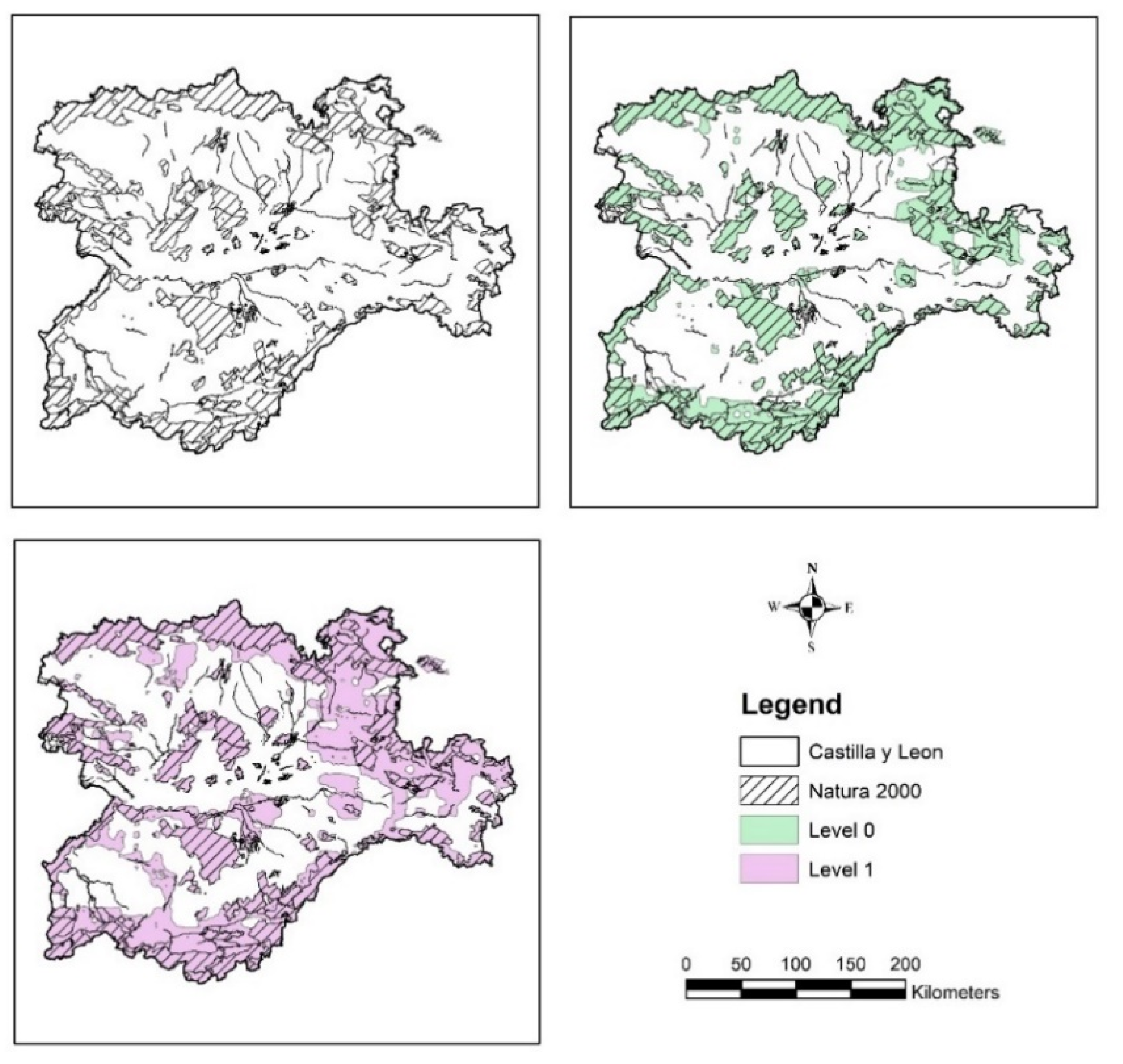

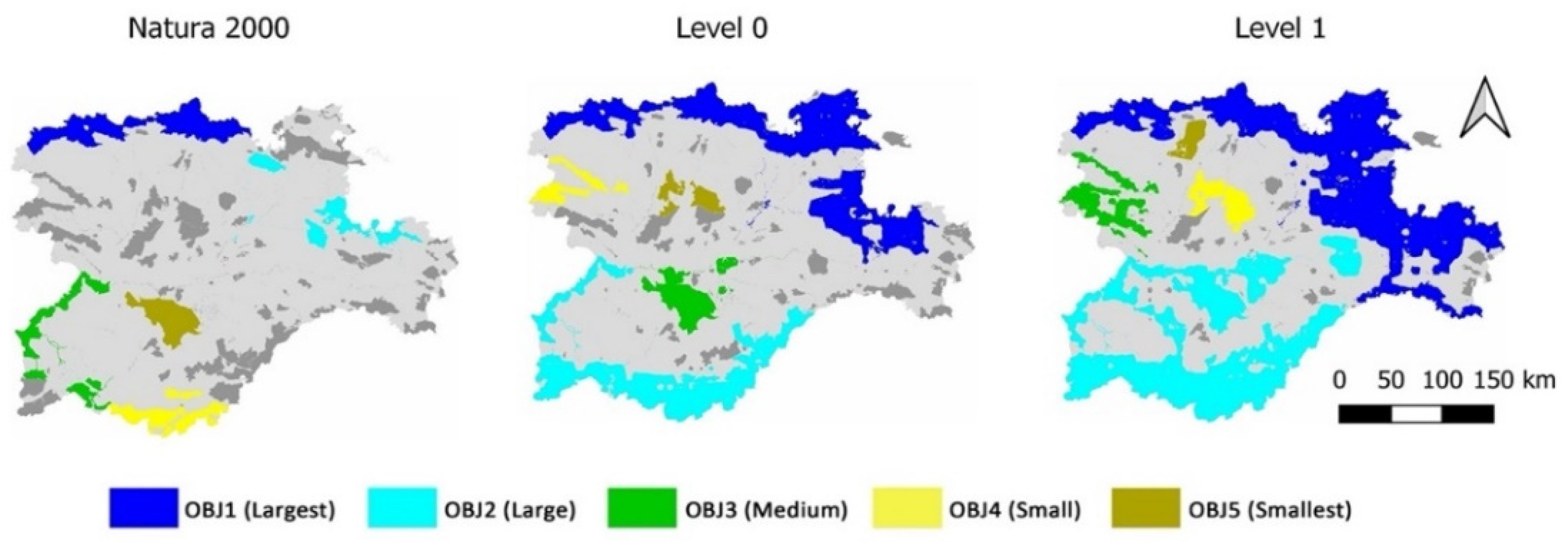
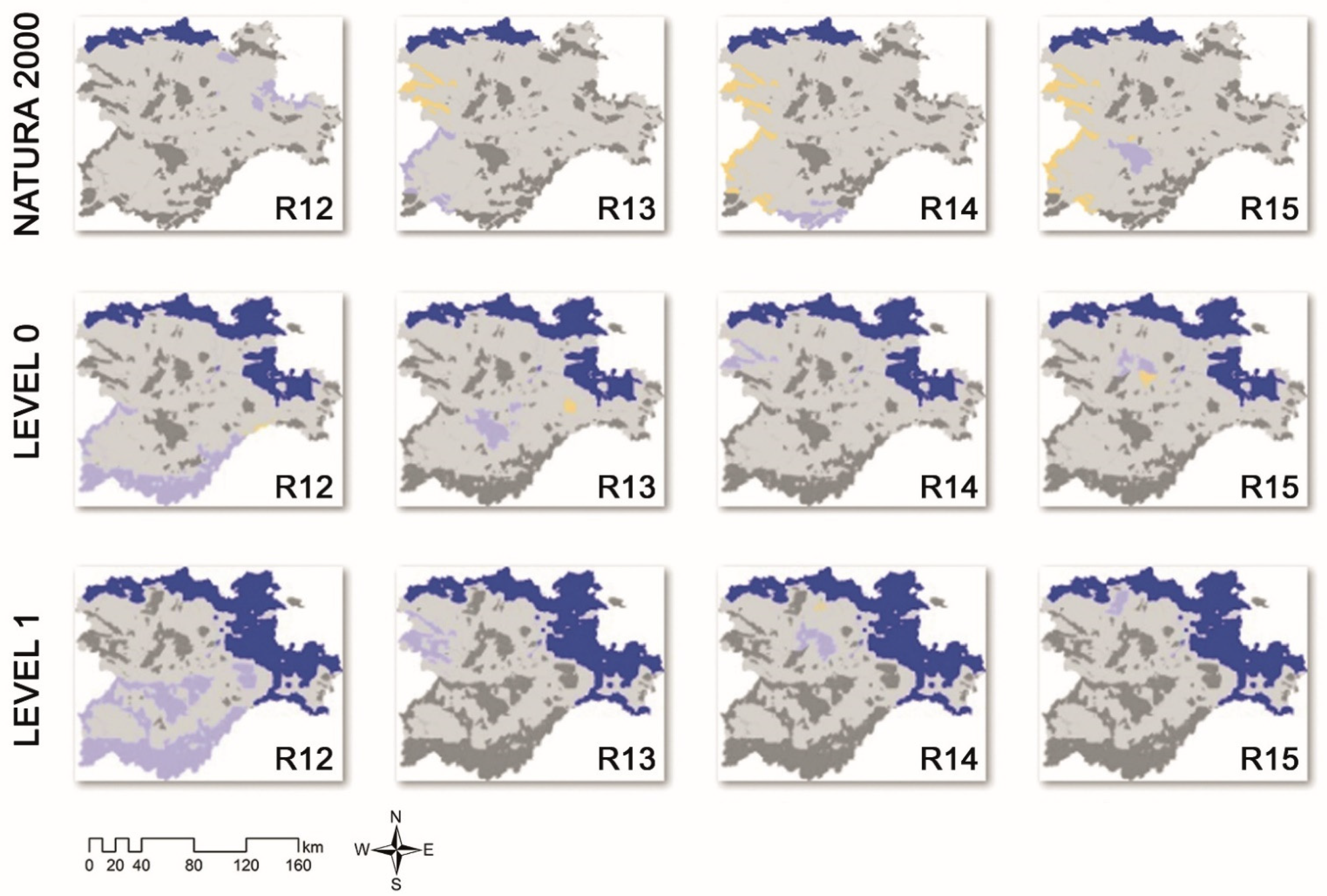
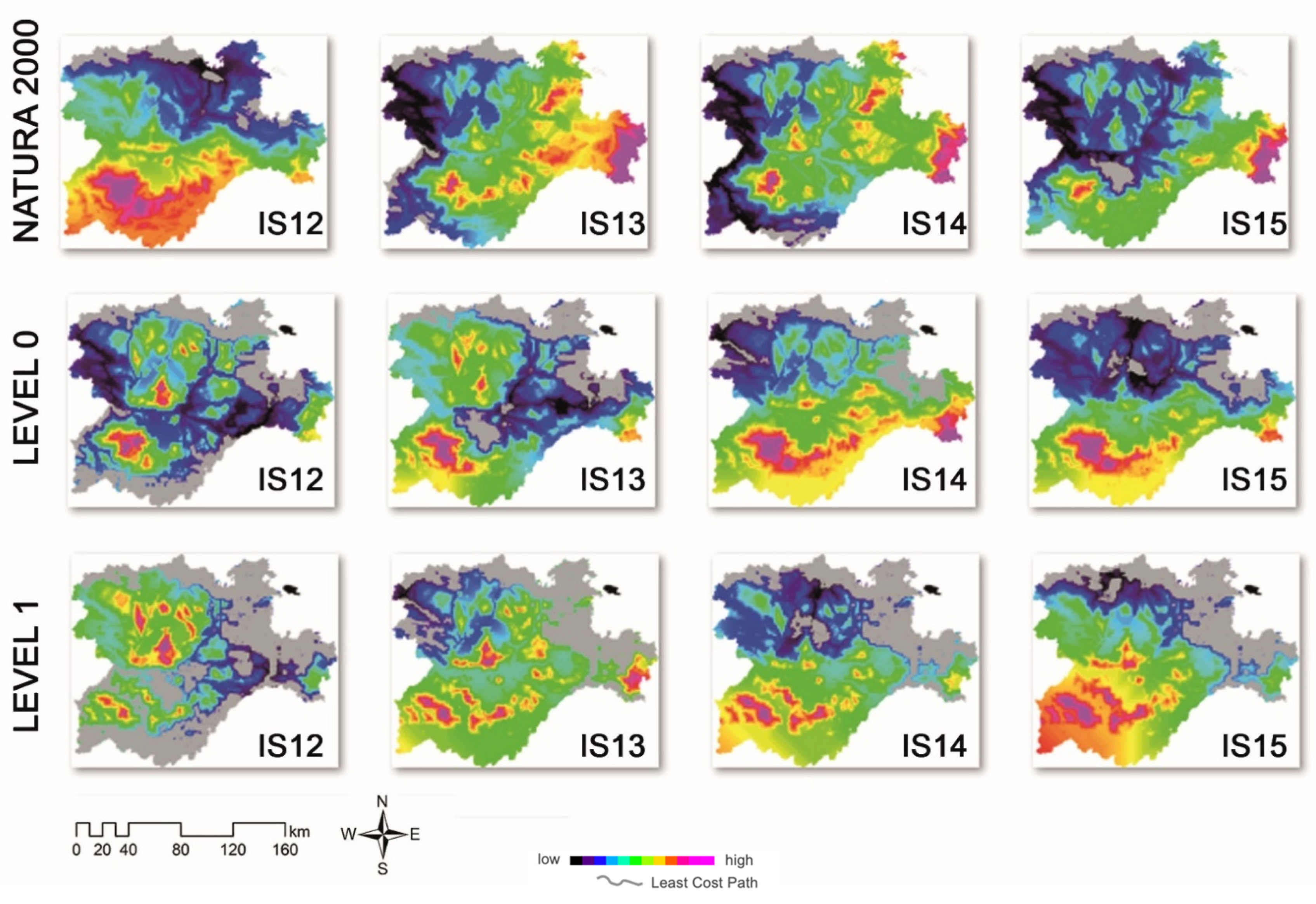
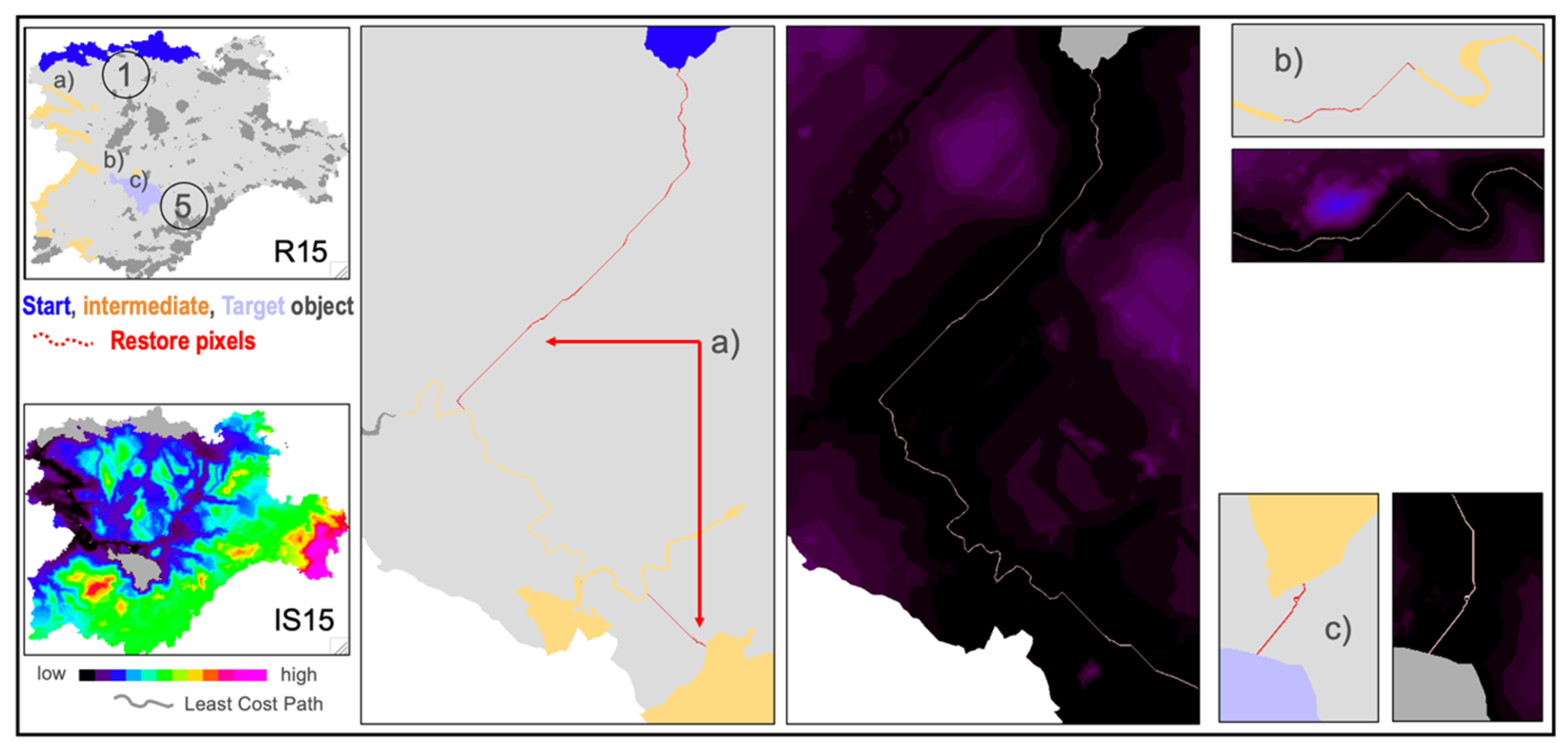
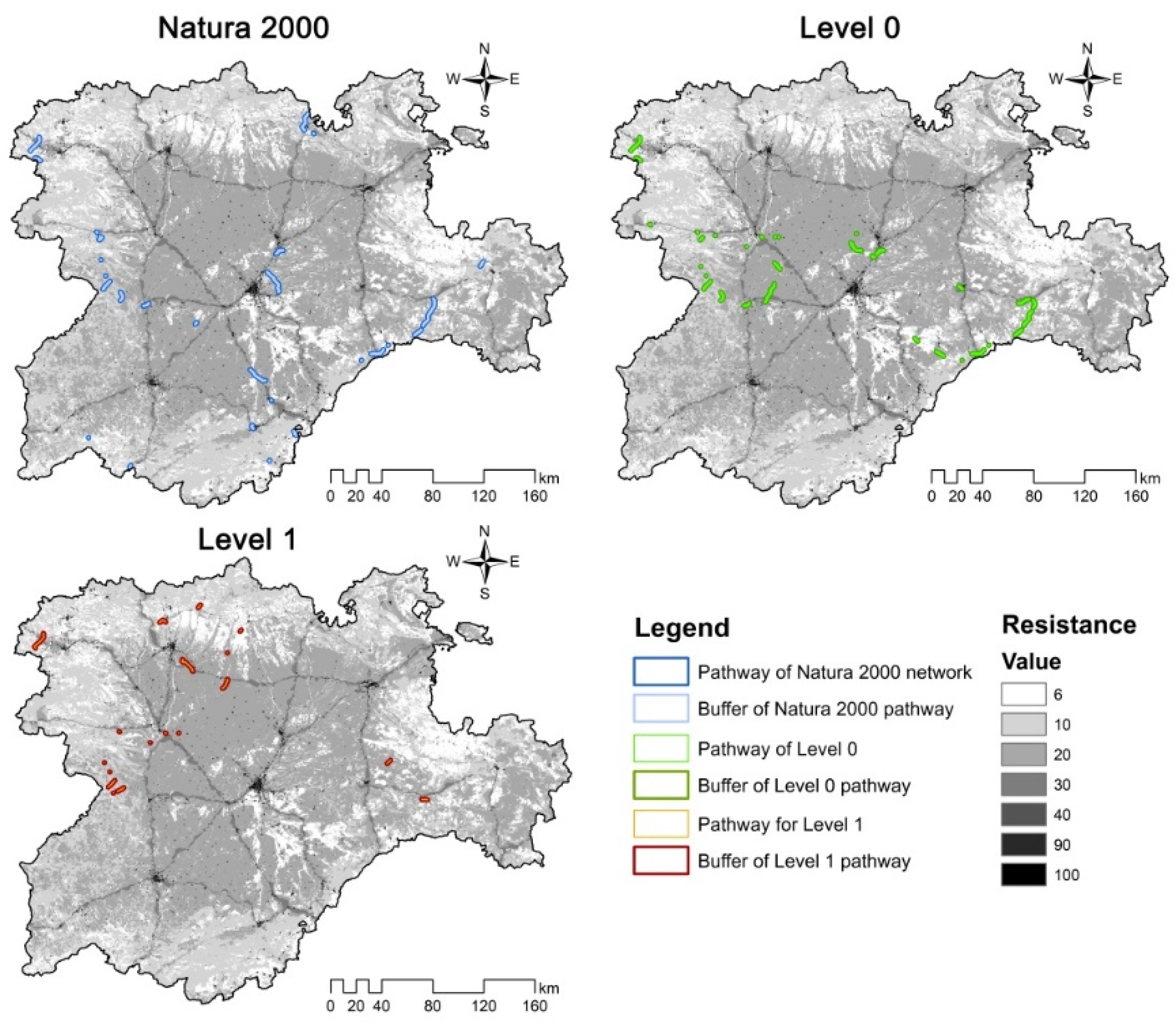
| REP_UNIT | AREA [pixels] | RAC [%] | NR_OBJ [-] | LARG_OBJ [pixels] | APS [pixels] | CNOA [pixels] | ECA [pixels] | COH [%] | REST_POT [%] |
|---|---|---|---|---|---|---|---|---|---|
| Natura2000.tif | 61,472,971 | 26.20 | 1114 | 10,400,331 | 55,182.20 | 8,650,228 | 15,760,731 | 25.64 | 74.36 |
| Level0.tif | 85,809,117 | 36.46 | 1055 | 34,393,092 | 81,335.66 | 56,202,021 | 42,619,979 | 49.67 | 50.33 |
| Level1.tif | 121,309,440 | 51.54 | 945 | 54,366,560 | 128,369.77 | 134,402,408 | 72,429,448 | 59.71 | 40.29 |
| SORT | RESTORE | SIZE_A [pixels] | SIZE_B [pixels] | REST_PIX [-] | AVDIST_RP [pixels] | EXP_var [-] | EFFIC [pixels] | ECA_ORIG [pixels] | ECA_NEW [pixels] | DELTA_ECA [pixels] | COH_ORIG [%] | COH_NEW [%] | DELTA_COH [%] |
| 1 | 1 <-> 2 | 10,400,331 | 5,210,361 | 1000 | 180.16 | 8412 | 375.87 | 15,760,731 | 18,922,540 | 3,161,809 | 25.64 | 30.78 | 5.14 |
| 2 | 1 <-> 3 | 10,400,331 | 4,999,542 | 1671 | 108.58 | 14,222 | 461.92 | 15,760,731 | 22,330,219 | 6,569,488 | 25.64 | 36.32 | 10.69 |
| 3 | 1 <-> 4 | 10,400,331 | 4,906,322 | 1679 | 108.07 | 14,298 | 739.28 | 15,760,731 | 26,330,916 | 10,570,185 | 25.64 | 42.83 | 17.19 |
| 4 | 1 <-> 5 | 10,400,331 | 4,530,553 | 2064 | 94.83 | 21,970 | 481.62 | 15,760,731 | 26,341,920 | 10,581,189 | 25.64 | 42.85 | 17.21 |
| 5 | 2 <-> 3 | 5,210,361 | 4,999,542 | 2011 | 124.33 | 22,492 | 78.75 | 15,760,731 | 17,532,050 | 1,771,319 | 25.64 | 28.52 | 2.88 |
| 6 | 2 <-> 4 | 5,210,361 | 4,906,322 | 3598 | 165.61 | 28,560 | 171.14 | 15,760,731 | 20,648,502 | 4,887,771 | 25.64 | 33.59 | 7.95 |
| 7 | 2 <-> 5 | 5,210,361 | 4,530,553 | 1860 | 125.34 | 18,032 | 89.96 | 15,760,731 | 17,382,962 | 1,622,231 | 25.64 | 28.28 | 2.64 |
| 8 | 3 <-> 4 | 4,999,542 | 4,906,322 | 2 | 1.41 | 40 | 37,157.01 | 15,760,731 | 17,247,011 | 1,486,280 | 25.64 | 28.06 | 2.42 |
| 9 | 3 <-> 5 | 4,999,542 | 4,530,553 | 439 | 49.60 | 8140 | 190.77 | 15,760,731 | 17,313,596 | 1,552,865 | 25.64 | 28.16 | 2.53 |
| 10 | 4 <-> 5 | 4,906,322 | 4,530,553 | 1152 | 174.10 | 15,270 | 172.85 | 15,760,731 | 18,400,118 | 2,639,387 | 25.64 | 29.93 | 4.29 |
| SORT | RESTORE | SIZE_A [pixels] | SIZE_B [pixels] | REST_PIX [-] | AVDIST_RP [pixels] | EXP_var [-] | EFFIC [pixels] | ECA_ORIG [pixels] | ECA_NEW [pixels] | DELTA_ECA [pixels] | COH_ORIG [%] | COH_NEW [%] | DELTA_COH [%] |
| 1 | 1 <-> 2 | 34,393,092 | 23,831,169 | 2566 | 132.04 | 19,524 | 851.07 | 42,619,979 | 59,236,327 | 16,616,348 | 49.67 | 69.03 | 19.36 |
| 2 | 1 <-> 3 | 34,393,092 | 6,146,606 | 885 | 91.42 | 10,786 | 507.41 | 42,619,979 | 48,092,870 | 5,472,891 | 49.67 | 56.05 | 6.38 |
| 3 | 1 <-> 4 | 34,393,092 | 2,864,889 | 967 | 126.98 | 6640 | 342.31 | 42,619,979 | 44,892,911 | 2,272,932 | 49.67 | 52.32 | 2.65 |
| 4 | 1 <-> 5 | 34,393,092 | 2,705,356 | 1529 | 118.44 | 13,764 | 216.96 | 42,619,979 | 45,606,172 | 2,986,193 | 49.67 | 53.15 | 3.48 |
| 5 | 2 <-> 3 | 23,831,169 | 6,146,606 | 531 | 77.09 | 3230 | 1089.53 | 42,619,979 | 46,139,166 | 3,519,187 | 49.67 | 53.77 | 4.10 |
| 6 | 2 <-> 4 | 23,831,169 | 2,864,889 | 563 | 103.20 | 5708 | 456.37 | 42,619,979 | 45,224,925 | 2,604,946 | 49.67 | 52.70 | 3.04 |
| 7 | 2 <-> 5 | 23,831,169 | 2,705,356 | 787 | 84.36 | 8498 | 402.85 | 42,619,979 | 46,043,397 | 3,423,418 | 49.67 | 53.66 | 3.99 |
| 8 | 3 <-> 4 | 6,146,606 | 2,864,889 | 849 | 85.42 | 12,238 | 516.11 | 42,619,979 | 48,936,094 | 6,316,115 | 49.67 | 57.03 | 7.36 |
| 9 | 3 <-> 5 | 6,146,606 | 2,705,356 | 1682 | 211.40 | 24,962 | 30.61 | 42,619,979 | 43,384,159 | 764,180 | 49.67 | 50.56 | 0.89 |
| 10 | 4 <-> 5 | 2,864,889 | 2,705,356 | 102 | 7.70 | 1600 | 233.25 | 42,619,979 | 42,993,181 | 373,202 | 49.67 | 50.10 | 0.43 |
| SORT | RESTORE | SIZE_A [pixels] | SIZE_B [pixels] | REST_PIX [-] | AVDIST_RP [pixels] | EXP_var [-] | EFFIC [pixels] | ECA_ORIG [pixels] | ECA_NEW [pixels] | DELTA_ECA [pixels] | COH_ORIG [%] | COH_NEW [%] | DELTA_COH [%] |
| 1 | 1 <-> 2 | 34,393,092 | 23,831,169 | 2566 | 132.04 | 19,524 | 851.07 | 42,619,979 | 59,236,327 | 16,616,348 | 49.67 | 69.03 | 19.36 |
| 2 | 1 <-> 3 | 34,393,092 | 6,146,606 | 885 | 91.42 | 10,786 | 507.41 | 42,619,979 | 48,092,870 | 5,472,891 | 49.67 | 56.05 | 6.38 |
| 3 | 1 <-> 4 | 34,393,092 | 2,864,889 | 967 | 126.98 | 6640 | 342.31 | 42,619,979 | 44,892,911 | 2,272,932 | 49.67 | 52.32 | 2.65 |
| 4 | 1 <-> 5 | 34,393,092 | 2,705,356 | 1529 | 118.44 | 13,764 | 216.96 | 42,619,979 | 45,606,172 | 2,986,193 | 49.67 | 53.15 | 3.48 |
| 5 | 2 <-> 3 | 23,831,169 | 6,146,606 | 531 | 77.09 | 3230 | 1089.53 | 42,619,979 | 46,139,166 | 3,519,187 | 49.67 | 53.77 | 4.10 |
| 6 | 2 <-> 4 | 23,831,169 | 2,864,889 | 563 | 103.20 | 5708 | 456.37 | 42,619,979 | 45,224,925 | 2,604,946 | 49.67 | 52.70 | 3.04 |
| 7 | 2 <-> 5 | 23,831,169 | 2,705,356 | 787 | 84.36 | 8498 | 402.85 | 42,619,979 | 46,043,397 | 3,423,418 | 49.67 | 53.66 | 3.99 |
| 8 | 3 <-> 4 | 6,146,606 | 2,864,889 | 849 | 85.42 | 12,238 | 516.11 | 42,619,979 | 48,936,094 | 6,316,115 | 49.67 | 57.03 | 7.36 |
| 9 | 3 <-> 5 | 6,146,606 | 2,705,356 | 1682 | 211.40 | 24,962 | 30.61 | 42,619,979 | 43,384,159 | 764,180 | 49.67 | 50.56 | 0.89 |
| 10 | 4 <-> 5 | 2,864,889 | 2,705,356 | 102 | 7.70 | 1600 | 233.25 | 42,619,979 | 42,993,181 | 373,202 | 49.67 | 50.10 | 0.43 |
Publisher’s Note: MDPI stays neutral with regard to jurisdictional claims in published maps and institutional affiliations. |
© 2022 by the authors. Licensee MDPI, Basel, Switzerland. This article is an open access article distributed under the terms and conditions of the Creative Commons Attribution (CC BY) license (https://creativecommons.org/licenses/by/4.0/).
Share and Cite
Velázquez, J.; Gülçin, D.; Vogt, P.; Rincón, V.; Hernando, A.; Gutiérrez, J.; Özcan, A.U.; Çiçek, K. Planning Restoration of Connectivity and Design of Corridors for Biodiversity Conservation. Forests 2022, 13, 2132. https://doi.org/10.3390/f13122132
Velázquez J, Gülçin D, Vogt P, Rincón V, Hernando A, Gutiérrez J, Özcan AU, Çiçek K. Planning Restoration of Connectivity and Design of Corridors for Biodiversity Conservation. Forests. 2022; 13(12):2132. https://doi.org/10.3390/f13122132
Chicago/Turabian StyleVelázquez, Javier, Derya Gülçin, Peter Vogt, Víctor Rincón, Ana Hernando, Javier Gutiérrez, Ali Uğur Özcan, and Kerim Çiçek. 2022. "Planning Restoration of Connectivity and Design of Corridors for Biodiversity Conservation" Forests 13, no. 12: 2132. https://doi.org/10.3390/f13122132
APA StyleVelázquez, J., Gülçin, D., Vogt, P., Rincón, V., Hernando, A., Gutiérrez, J., Özcan, A. U., & Çiçek, K. (2022). Planning Restoration of Connectivity and Design of Corridors for Biodiversity Conservation. Forests, 13(12), 2132. https://doi.org/10.3390/f13122132











